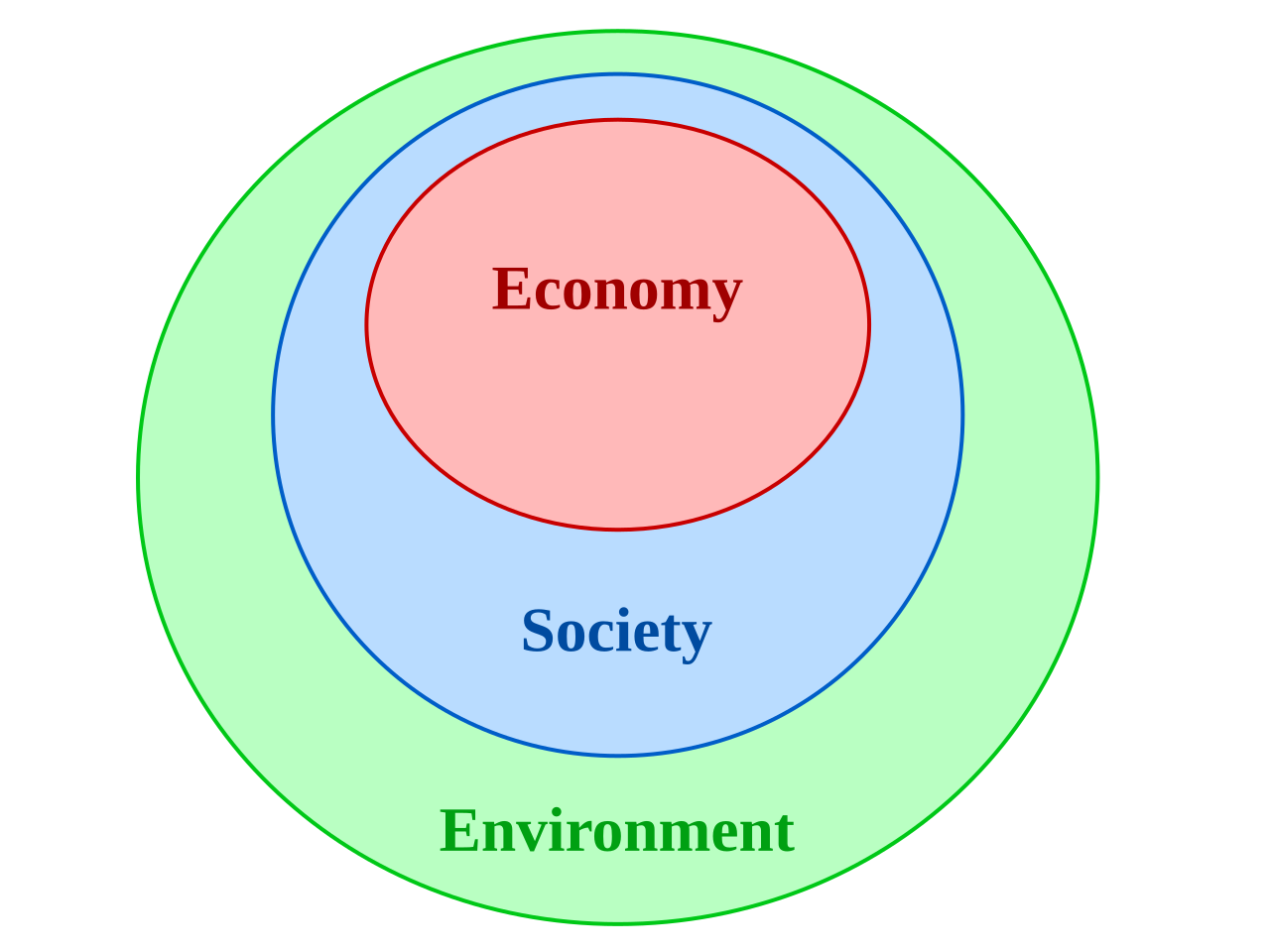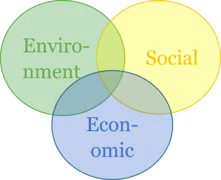IB Syllabus focus:
‘Sustainability rests on environmental, social, and economic pillars. Strong models embed economy in society within nature; weak models show partial overlap among pillars.’
Sustainability is best understood through three key pillars—environmental, social, and economic. Each pillar contributes to long-term stability, and models help illustrate their interconnections and limitations.
The Three Pillars of Sustainability
Environmental Pillar
The environmental pillar refers to the responsible use of natural resources, maintaining ecosystem integrity, and protecting biodiversity to ensure the earth’s life-support systems remain functional.
It includes strategies such as renewable energy use, pollution reduction, sustainable agriculture, and conservation.
This pillar underpins the other two because without a stable environment, both economic and social systems eventually collapse.
Environmental Sustainability: The practice of managing natural resources and ecological systems to ensure long-term stability and regeneration without degrading the environment.
Social Pillar
The social pillar centres on equity, justice, and community well-being. It ensures societies are fair, inclusive, and resilient.
Key features include health care, education, human rights, and cultural diversity.
It stresses fairness in access to resources and opportunities across generations and within communities.
A strong social foundation allows societies to support environmental initiatives and foster long-term economic growth.
Social Sustainability: The maintenance of social quality through equity, access to resources, human rights, and cultural preservation for both present and future generations.
Economic Pillar
The economic pillar focuses on ensuring development and financial stability without exhausting resources or creating extreme inequalities.
Long-term strategies such as circular economies, responsible trade, and green technologies belong here.
Short-term economic gains at the expense of environmental or social systems undermine sustainability.
Economic Sustainability: The capacity of an economy to support a defined level of economic production, consumption, and financial security over the long term, without exhausting supporting systems.
Sustainability Models
Strong Sustainability Models
In strong models, the economy is embedded within society, which itself exists within the environment.

Concentric “nested dependencies” diagram showing Economy inside Society, nested within Environment, illustrating a strong sustainability view in which human and economic systems depend on ecological limits. Labels are concise and match the subsubtopic’s required terminology. Source.
The environment is seen as the ultimate support system.
Nature has clear limits that must not be breached.
Human and economic activities are entirely dependent on environmental integrity.
This model supports the idea of planetary boundaries and prioritises ecological protection over short-term human demands.
Key features of strong sustainability:
Non-substitutable natural capital (forests, atmosphere, biodiversity cannot simply be replaced).
Strict adherence to ecological limits.
Policies often include conservation zones, carbon caps, and ecological restoration projects.
Weak Sustainability Models
In weak models, the three pillars are drawn as partially overlapping circles.

Simple Venn diagram of the environmental, social, and economic pillars with an overlapping centre representing sustainability and trade-offs—aligned with the weak model discussed in the notes. If the version on this page includes minimal extra labels, they serve only to clarify overlaps and remain within the subsubtopic scope. Source.
This suggests that trade-offs between pillars are possible, meaning environmental degradation could be offset by social or economic growth.
While useful for visualising connections, it risks oversimplifying reality.
Weak sustainability assumes substitutability of natural capital—that technological innovation or human systems can replace lost natural resources.
Key features of weak sustainability:
Prioritises flexibility and growth.
Tolerates environmental losses if perceived benefits occur socially or economically.
Criticised for underestimating ecological thresholds.
Importance of Interconnections
The three pillars are not isolated. They interact continuously:
Environmental degradation leads to social challenges (e.g., pollution causing health crises).
Social inequality weakens environmental cooperation (e.g., marginalised groups lacking access to clean water).
Economic instability can undermine environmental protections (e.g., prioritising short-term profits over long-term sustainability).
For true sustainability, all three must reinforce one another rather than compete.
Comparing Models
Advantages of Strong Models
Provide clear ecological limits.
Prevent irreversible damage.
Better suited to global environmental challenges like climate change.
Limitations of Strong Models
Can appear restrictive to economic development.
Politically difficult to enforce.
Advantages of Weak Models
Allow flexibility for decision-making.
Emphasise cooperation and integration of sectors.
Limitations of Weak Models
May underestimate environmental limits.
Encourage risky assumptions about technological solutions.
Applications of Sustainability Models
Governments, organisations, and international bodies apply these models when shaping policies and actions.
Strong models often guide international agreements such as biodiversity treaties or carbon reduction commitments.
Weak models are common in urban planning, corporate sustainability reports, and policies balancing growth with environmental management.
Ultimately, the choice of model shapes how societies interpret trade-offs between human needs and ecological health. Strong models emphasise absolute limits, while weak models stress balancing priorities.
FAQ
The three-pillar model emerged in the late 20th century, particularly after the 1987 Brundtland Report. It was developed as a way to frame sustainability in a simple, accessible format for policymakers. The model gained popularity because it integrates environmental, social, and economic aspects, showing that true sustainability requires balance between all three.
Strong sustainability assumes that natural capital (forests, atmosphere, biodiversity) is non-substitutable. Unlike weak models, which suggest human-made capital can replace natural systems, strong models emphasise that once lost, some ecological functions cannot be restored. This concept underlines the need for strict environmental thresholds.
Policymakers weigh factors such as economic pressures, public opinion, and ecological risks.
Strong models are often adopted in global agreements on climate change or biodiversity.
Weak models are more common in urban planning, where development goals must coexist with environmental management.
The choice reflects priorities: ecological limits versus growth flexibility.
Yes, the emphasis changes with scale.
Local scale: social needs (jobs, health, equity) may dominate, with environmental issues addressed through community-level initiatives.
Global scale: environmental limits (climate stability, biodiversity loss) are prioritised as they underpin all social and economic systems worldwide.
Critics argue the framework oversimplifies sustainability by dividing it into three neat categories.
It may obscure the interdependence of systems.
The model does not fully capture cultural, political, or ethical dimensions of sustainability.
Alternatives, such as doughnut economics or planetary boundaries, attempt to address these limitations with more holistic approaches.
Practice Questions
Question 1 (2 marks):
Identify the three pillars of sustainability.
Mark scheme:
1 mark for each correctly identified pillar:
Environmental (1)
Social (1)
Economic (1)
(Maximum 2 marks.)
Question 2 (5 marks):
Explain the difference between strong and weak sustainability models, and outline one strength and one limitation of each model.
Mark scheme:
Clear distinction between strong and weak sustainability models (2 marks total):
Strong: economy embedded in society within environment, recognising ecological limits. (1)
Weak: overlapping circles, allows trade-offs between pillars, assumes substitutability of natural capital. (1)
Strength of strong model: e.g., provides ecological limits, prevents irreversible damage. (1)
Limitation of strong model: e.g., restrictive to economic growth, politically difficult. (1)
Strength of weak model: e.g., flexible, integrates sectors. (1)
Limitation of weak model: e.g., underestimates environmental thresholds, risky assumptions. (1)
(Maximum 5 marks.)

